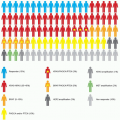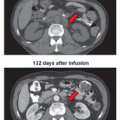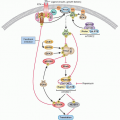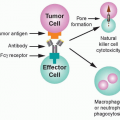|
Cutaneous Features |
Internal Tumor Site |
Benign cutaneous features prominent |
Cowden syndrome1,2 |
Trichilemmoma, palmoplantar keratoses, oral mucosal papillomas, cutaneous facial papules, lipomas, macular pigmentation of the glans penis |
Breast, thyroid, uterus |
Birt-Hogg-Dubé3 |
Fibrofolliculomas, trichodiscomas, angiofibromas, perifollicular fibromas, acrochordons |
Kidney |
Childhood cancer syndrome (homozygous Lynch syndrome)4 |
Neurofibromas, CALMs |
Hematologic, neural system, colon, small intestine, urinary tract |
Hereditary leiomyomatosis renal cell carcinoma5 |
Cutaneous leiomyomas |
Kidney, uterus |
Multiple endocrine neoplasia type 2B6 |
Mucosal neuromas of the lips/tongue |
Thyroid, adrenal gland, gastrointestinal tract |
NF17,8 |
Neurofibromas (cutaneous and subcutaneous), CALMs, freckling (inguinal, axillary), hypopigmented macules, cutaneous angiomas xanthogranulomas, glomus tumors, hyperpigmentation |
Brain, spine, peripheral nervous system, optic pathway, small intestine, neuroendocrine, breast |
NF27,9 |
CALMs (usually one to three), plaque lesions, intradermal schwannomas, subcutaneous schwannomas, cutaneous neurofibromas (uncommon) |
Brain, spine, peripheral nervous system, optic pathway |
Peutz-Jeghers syndrome10 |
Mucocutaneous pigmentation |
Breast, stomach, small intestine, colon, pancreas, ovary, testicle |
Tuberous sclerosis complex11 |
Hypomelanotic macules, facial angiofibromas, shagreen patches, fibrous facial plaques, ungual fibromas |
Brain, kidney, heart, neuroendocrine |
Benign cutaneous features sometimes present |
Multiple endocrine neoplasia type 112 |
Facial angiofibromas, collagenomas, lipomas |
Pituitary, pancreas, parathyroid, gastroenteropancreatic tract |
Familial adenomatous polyposis13 |
Lipomas, fibromas, and epidermal cysts |
Colon, thyroid, small intestine, liver, brain, pancreas, ampulla of Vater |
Skin cancer prominent |
BCNS14 |
Basal cell carcinoma |
Brain, ovary, heart |
Hereditary melanoma15 |
Melanoma, dysplastic nevi |
Pancreas |
Xeroderma pigmentosum16 |
Melanoma, basal cell and squamous cell carcinoma, severe sunburn, lentigos, xerosis, erythema, actinic keratoses, poikiloderma |
Oral cavity |
Skin cancer sometimes present |
Hereditary breast and ovarian cancer syndrome17 |
Melanoma |
Breast, ovary, prostate, pancreas |
Lynch syndrome18 |
Sebaceous neoplasms, keratoacanthomas |
Colon, uterus, stomach, ovary, hepatobiliary tract, urinary tract, small intestine, brain |
CALM, café-au-lait macule; NF1, neurofibromatosis type 1; NF2, neurofibromatosis type 2; BCNS, basal cell nevus syndrome. |
|









